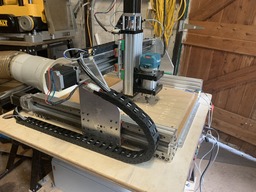Sphinx 66
Discussion in 'CNC Mills/Routers' started by Lappa, Apr 17, 2023.
Sphinx 66
Discussion in 'CNC Mills/Routers' started by Lappa, Apr 17, 2023.
A Sphinx Linear rail build (600mm x 600mm) hence the title Sphinx66. Plates supplied by Chris Laidlaw. Linear rails used MGN15

